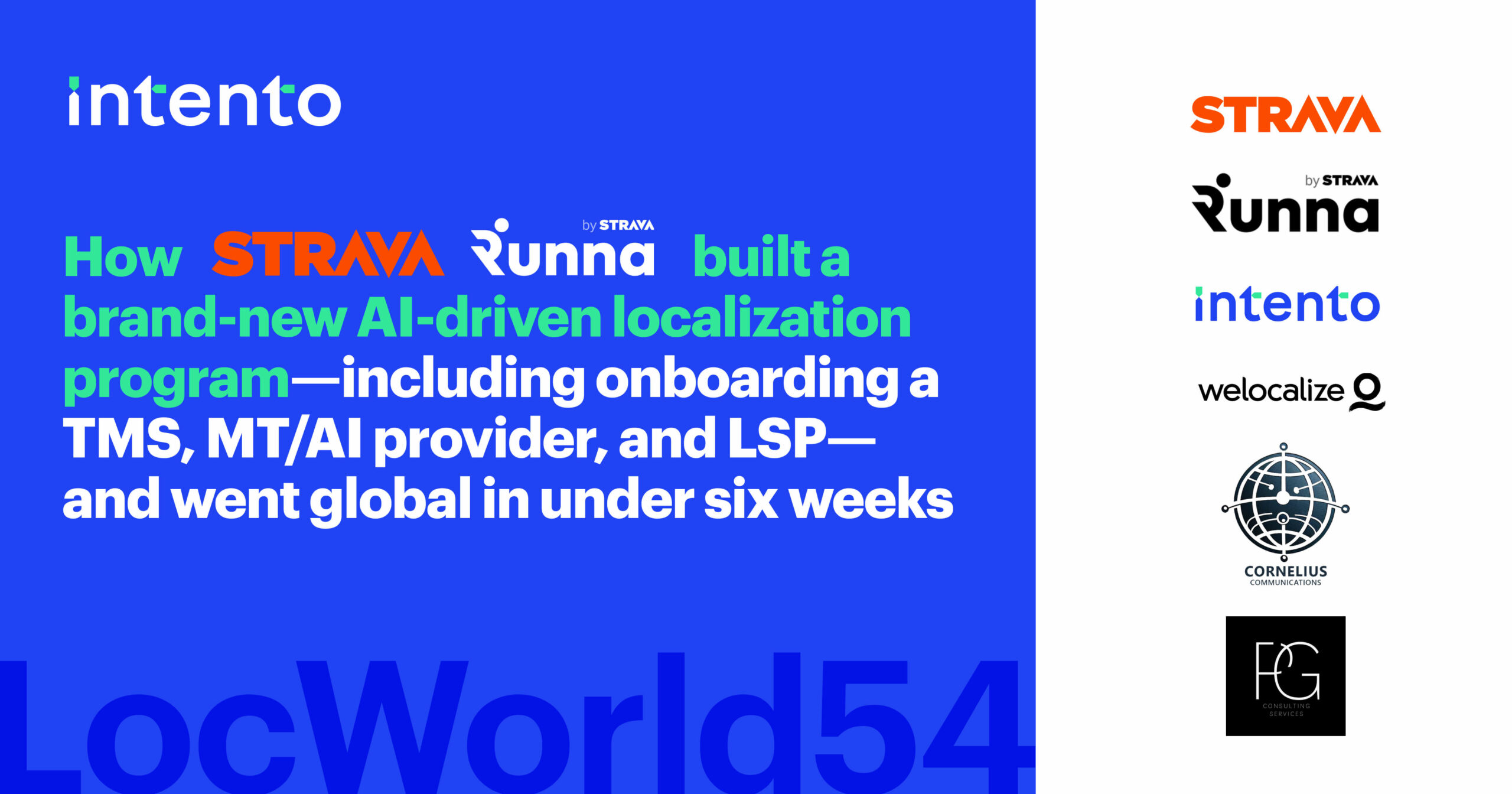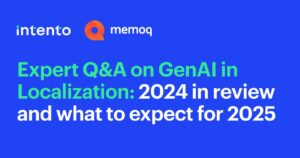When Strava acquired Runna, a top-rated running coaching app, they faced a challenge that would stretch any localization team: to take a single-language, single-market acquisition and expand it globally in record time.
At LocWorld54 Monterey, Pascale Tremblay (Pascale Global Consulting), Daria Sinitsyna (Intento), Ben Cornelius (Cornelius Communications), and Paul Danter (Welocalize) shared how this ambitious project delivered over two million words across seven languages, established a complete localization infrastructure, and yielded significant business results—all in just six weeks. Here’s how they did it.
Speed as the critical success factor
“The inspiration for this was actually ‘how quickly can we take a new acquisition from a single market, single language, and expand globally with incredibly fast ROI?'” explained Ben Cornelius, the language consultant who guided the project. “We’re talking about shattering the usual time barrier.”
The project didn’t begin with a mandate to use AI or follow a specific approach. Instead, leadership focused on results rather than prescribing specific technologies.
“In a lot of engagements, there’s either grassroots pressure to adopt AI or a leadership-level, top-down directive,” Ben noted. “In the case of the Runna and Strava team, it was a little different, because their core organization responsible for getting it done was given a lot more trust, a lot more leeway—not ‘I want to see AI embedded,’ but ‘I want to see results.'”
This freedom allowed the team to focus on the core challenge: speed.
Building a cross-organizational framework
Typical localization programs involve sequential handoffs between engineering, content creation, localization vendors, and QA teams. But with a six-week deadline, this approach would never work.
The team implemented a cross-organizational model where everyone worked simultaneously, not sequentially.
“It was marvelous meeting cross-functionally, cross-organizationally on a regular basis, so that we could really power up all the cubes to work in tandem, to make things happen simultaneously,” Ben said. “We didn’t have internationalization done by the time we started to build up our language base. All of this was happening simultaneously. Without that tight relationship, people just treating each other as an over-the-wall vendor—’Here are some files attached to my email. I’ll see you in a week’—that approach was great in 1987, but it couldn’t possibly be successful in a program as quick as this.”
This approach meant breaking down traditional barriers between companies, too.
Paul Danter, GM of Localization for Welocalize, explained his role: “Really making sure that we could run hand in hand, not as one partner, but as a series of partners, making sure that we could coordinate all of our efforts to meet the time frame that we were tasked with delivering.”
A six-week technology sprint
On the technology side, the team faced what seemed impossible: deploying a complete machine translation program enhanced with AI in record time.
“The role of my team in this project was to very quickly onboard a solution in seven languages for 200,000+ words,” explained Daria Sinitsyna, Lead AI Engineer at Intento. “When we say that the whole project was done in under six weeks, for the engineering team we had to do it in under a week and a half.”
This required abandoning the normal, methodical evaluation process. “We couldn’t just do our standard evaluation where we would look at several providers, assess which one best meets the requirements. We had to do it really fast.”
The guiding principle emphasized pragmatism over perfection. “Do not let perfect be the enemy of good. Do not let yourself be stuck trying to achieve the best possible result immediately. That never works out,” Daria noted.
“Strava was really quick to give us the requirements that we needed to meet, the terminology, and the glossaries that were thankfully provided by Welocalize. That’s not something that happens a lot with technology projects. Usually we have to collect glossaries ourselves, which is a very long process even when it’s automated.”
When asked what was different in their approach compared to standard projects, Daria explained: “We could not have fit this into a week and a half for seven languages if we had done what we usually do… we get all the client requirements and we try to abide by them using fine-tuning, training, customization, then using GenAI, using machine translation technology as much as possible.” Instead, the team had to make rapid decisions and trust their partner’s expertise.
Daria added that while the initial phase was compressed, “thankfully, we have time later on to do the full language setup that we usually perform for clients, and we’ll get even better results.” This hybrid approach—rapid initial deployment followed by ongoing refinement—became a valuable new capability for the team.
While Strava’s timeline was challenging, the scenario wasn’t unusual for Intento. Many software companies face similar time-to-market pressures when expanding globally. Businesses typically want to enter new markets and see revenue impact within the same fiscal year—nearly impossible with traditional localization workflows.
New language expansion usually means starting with no linguistic assets, no translators familiar with company style, and no established workflows. Intento addresses these challenges by deploying AI agents specifically instructed to verify and meet all translation requirements, enabling enterprises to fully automate translation even without existing language assets or historical data.
The team built an open-ecosystem approach that could adapt to future needs. “Because we don’t know what the future is going to be, but if you create an environment, an ecosystem of vendors that can actually bend and fit into what the future is going to bring and offer, then I think you’re heading for success,” Paul noted.
The changing role of human translators
Though AI and automation drove much of the project, the team highlighted how language professionals now play a different but crucial role in the process.
“It’s not just access to resources, it’s about managing the complexity that sits in between all of those things,” Paul explained, highlighting that language service providers bring more than just linguists to the table.
Translators are becoming language-governance and brand-reflection specialists. “You’ll see a trend where you really need to be able to find individuals who are not only linguistically capable but are also potentially domain specialists in an area,” he explained.
“In the example of Runna and Strava, you want to have translators who are passionate about and understand that community, because they’re going to reflect the brand. And if you can’t provide access to that, then the balance between technology and humans is going to be broken.”
Business impact and lessons learned
The results of this ambitious project impressed Strava’s leadership. Ben noted: “Within three months of the acquisition, there was significant uplift in revenue and MAUs (monthly active users).”
Strava’s success demonstrated what’s possible when localization is treated as a business accelerator. Ben emphasized how transformative this approach was compared to typical acquisition timelines: “In other situations I’ve seen, an acquisition took quite a long time to be absorbed and to increase its global presence, unlike the way the Strava team was able to do with Runna.”
More importantly, the project established a new benchmark for what’s possible in localization timelines.
“The biggest challenge was seeing how fast it could be done—and then achieving it in a way that had such resonance, not just with the market, but with the leadership and the other stakeholders internally at the end of the day.”
When asked about the best part of the project, Daria added, “Cross-organizational communication. That was the best part about it… being able to collaborate with different teams from different groups. Being able to have those wonderful partners in this project was just great.”



